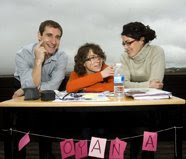

Why did i choose this book?
It’s the second book suggested by the TAE I read. It was in fact the book i wanted to read first. I was struck by the courageous simplicity of the title. Change the world, no more, no less. Of course, start changing yourself. I think it’s a biographical issue. I’ve gone through so many changes in life. Often I refer to my daily basis as swifting from a world into a different one. I have problems to connect the family realm with the job’s activities and relations. The same happens with the African friends and memories, with the group from architecture, who is not similar to the tasks at work, with the “hobby” at dance and theatre, with the Christian commitment, with
This is a book addressed to one’s personal change levers and motivations. It is hard on one’s pitfalls and barriers. It’s bold about one’s hypocrisy and misidentification of personal limits. It’s also an exercise book, not just to read, think about it and leave it behind. At least I feel compelled to implement what I’m reading. It can be a self-transformational book.
what is this book about?
It speaks about changing persons. About human growth and transformation both through life’s external changes which have an influence on the subjectivity and internal changes through maturity and commitment to life, which are put into behaviours, relations and actions. It explains a system for first changing oneself and then the surrounding world. It’s called the “advanced change theory”, ACT, a “set of action principles for more effectively introducing change to human systems”.
It speaks about freedom to become one’s highest self-image, and be accountable for it. It brings mature individuals into productive communities where members share a common purpose and work for the benefit of all. It reflects on the nature of hierarchy in order to introduce emergent adhocracy where groups become organisms and the leader is not a ruthless hero but an autothelic ordinary person able to flow with the reality and the persons around.
It starts by looking within oneself and making a fundamental choice for the life’s purpose which has found me. A choice which makes you true to yourself and opens a path of coherence where all you see is part of one large picture. Hypocrisy has then no room and the natural emergence of reality is not blocked by our former lack of integrity, ineffective behaviour, view on persons as things and purposelessness.
Many dilemmas are addressed, like the common good versus personal interest, solved by following the path of collective fulfilment being inner-directed and other-focused, moving on the edge of chaos from cycle to cycle. The dilemma of natural resistance to change is then seen as a feedback loop in which the change agent and the resisting system are joined in creative tension, nearer to reality than ever.
what have i learned?
This book has put together concepts which were separated for me. It serves as a guide through dilemmas in which i find myself deeply involved. This is all compressed into the task of becoming more autothelic, finding the courage to leave behind the script told by outside forces, disciplined by the 4 steps of “appreciative inquiry” (discovery, dream, design and destiny).
If I had any barrier to change and letting go, this books was heard in terms of faithfulness to my own process of unfolding. The core vision is not defined by personal survival, but by belonging to a productive community. Leadership is not fixed by position, but by spontaneous contribution. The state system is not under static equilibrium but under bounded instability. Social movements do not prevent insurgency but enact it. Empowerment is, beyond responsive, self-authorizing. Consciousness is not script driven anymore, but mindful and free. Moral reasoning does not answer to social expectations but to committed universal principles. Sanctions are not responded but transcended. The self is not divided but authentic. Communication of the self does not use symbols but turns oneself into a living symbol. Visions are not imitated and instructed but created and reframed.
All in all I think my sum up is forgetting the question “what do I have to lose?” and allowing myself to flow with reality. Another important point was brought by the “sacred servants” (Ghandi, M.L. King and Jesus of Nazareth), whose actions are used to illustrate the basic teachings of the book. Odd as they can be for today’s iconography, they where my hidden heroes, now to be brought to the front.
how will i implement what i've learned?
It’s not about doing things, it’s about being and becoming. There are a couple of beliefs I must check and transform into acts. I surrender to being a change agent for the growth of the world.




